The best mountain bike rear shocks will help control the movement of your rear wheel as the bike moves through its travel.
Rear shocks are a crucial part of every full-suspension mountain bike and while most follow a similar trend, the details of rear-shock design vary based on the intended use of the shock.
This guide will help you find the right shock for your riding and explore the different functions and technologies found on the best MTB rear shocks.
All of the rear shocks in this guide can be grouped into one of two categories – air or coil. This refers to the spring system used in the shock. Air shocks use a pressurised air spring to absorb forces from the trail, whereas coil shocks use a coil spring.
You can jump to the different types of shock by hitting the links below:
These two types of mountain bike shocks come with their own strengths and weaknesses. You can jump to our rear shock buyer's guide to find out more.
Best mountain bike rear shocks in 2024
Best MTB air shocks
The best mountain bike air shocks are commonplace on trail bikes and enduro bikes. Air shocks are generally lighter and easier to tune to a rider's weight and preferences than coil shocks.
Cane Creek DB Kitsuma Air
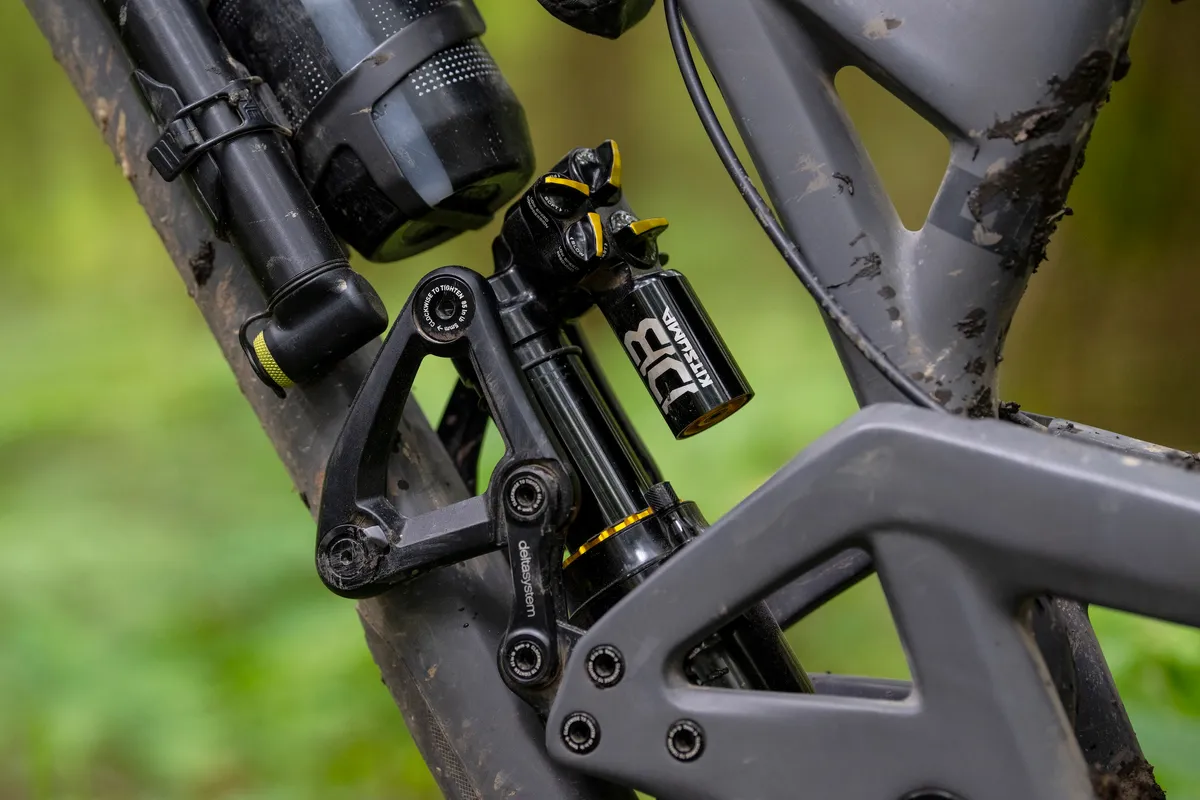
- £725 as tested
- Pros: Rebound tune is fast enough for a wide variety of riders; usable range of low-speed compression adjustment; should work with most frames without specific tuning
- Cons: High-speed knobs are stiff to turn and dial indexing is difficult to notice; amount of adjustment may be confusing for some
The Cane Creek DB Kitsuma is aimed at trail and enduro riders and continues Cane Creek’s commitment to its Double Barrel technology, delivering four-way external damping adjustment.
The adjustment is tool-free and the dials are all within easy reach, too, above the piggyback reservoir.
Overall, the Cane Creek DB Kitsuma Air is an impressive, high-performance shock that tracks the ground well. The highly adjustable rebound and compression settings will please the tech-tweakers, but the high-speed dials are stiff to turn, and if you’re a fit-and-forget rider, all this adjustability might not be important to you.
Fox Float X
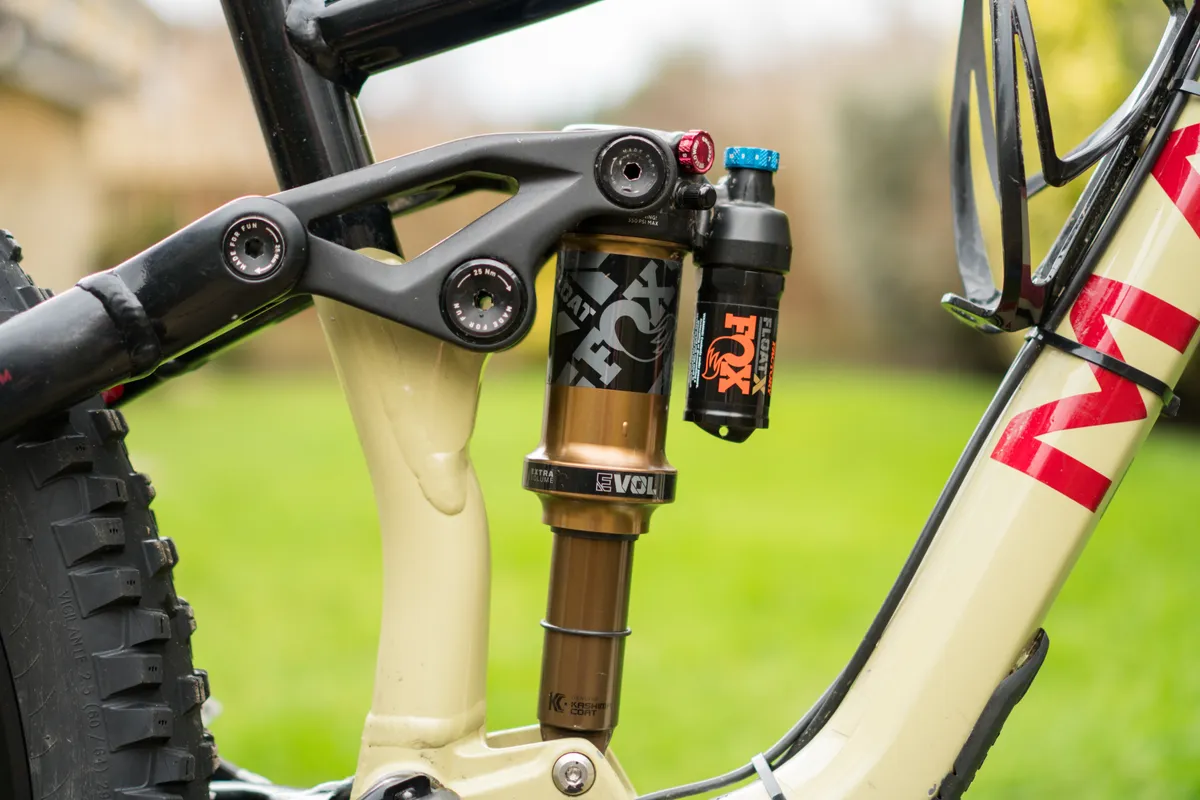
- £659/$569/€799 as tested
- Pros: Super-plush once it was in its travel; progressive mid-stroke and bottom-out resistance; no compression spike or packing down
- Cons: Needed a re-tune for best performance; rebound damping still too firm
The Fox Float X rear shock features a Kashima-coated stanchion with external low-speed rebound and compression adjustment.
The adjustability on the external dials is impressive, where even just a few clicks of low-speed compression or rebound damping had a marked effect on the way the shock performed.
On the trail, the Float X Factory is extremely smooth, particularly once it’s sitting at sag. Its plushness stands out as its dominant quality.
Hitting mid- to large-sized bumps including rocks, roots and braking bumps, it was ready to compress and absorb impacts, with no perceptible lag or stickiness as it compressed further into its travel.
For the price and weight, there’s little out there that can top the Float X’s performance.
However, we recommend finding out whether the stock tune is suitable for your bike’s kinematics, otherwise accessing the performance we experienced might require a retune.
Fox Float X2
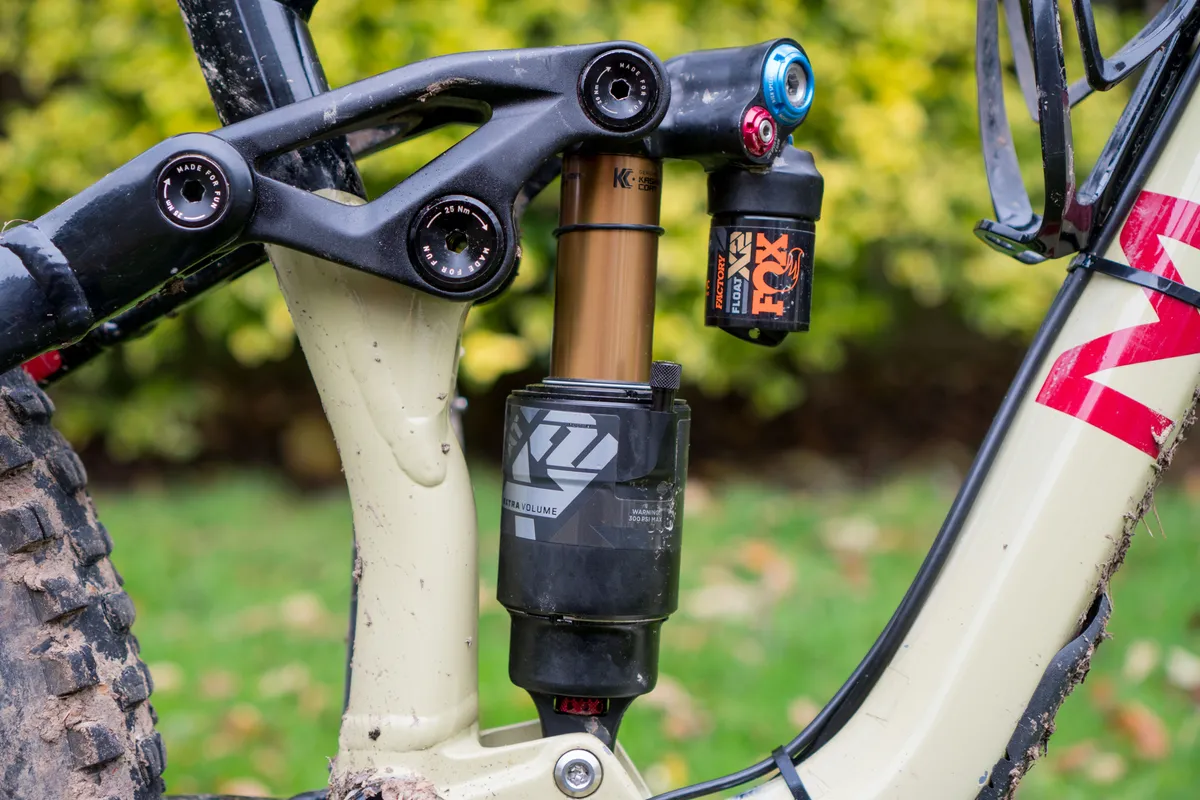
- £769 as tested
- Pros: Fantastic throughout its entire stroke; super-supple and fade-free performance; spring rate and progression adjustability a breeze
- Cons: Stock compression and rebound damping might be too hard for some people, resulting in the need to run all the adjusters fully open; hard to access high-speed rebound adjuster on some frames
Fox’s Float X2 Factory rear mountain bike shock is the brand’s highest-spec, most adjustable air-sprung damper, designed for tough conditions.
The massive amount of damping and spring rate adjustability of the Float X2 means it is a highly adaptable shock. Volume reducer spacers are easy to install or remove and, thanks to the Allen key external damping adjusters, trail-side adjustments are also a breeze.
Once set up, the Float X2 proved to be one of the most capable shocks we’ve tested, blending the fluttery nature of coil shocks with the mid-stroke and bottom-out ramp-up of an air spring.
Depending on the suspension leverage rates of the bike, and the damper that’s fitted, the Fox Float X2 Factory shock is arguably one of the best upgrades to improve performance. But lighter riders – in both style and weight – might feel it is over-damped, even with the adjustments set to fully open.
Marzocchi Bomber Air
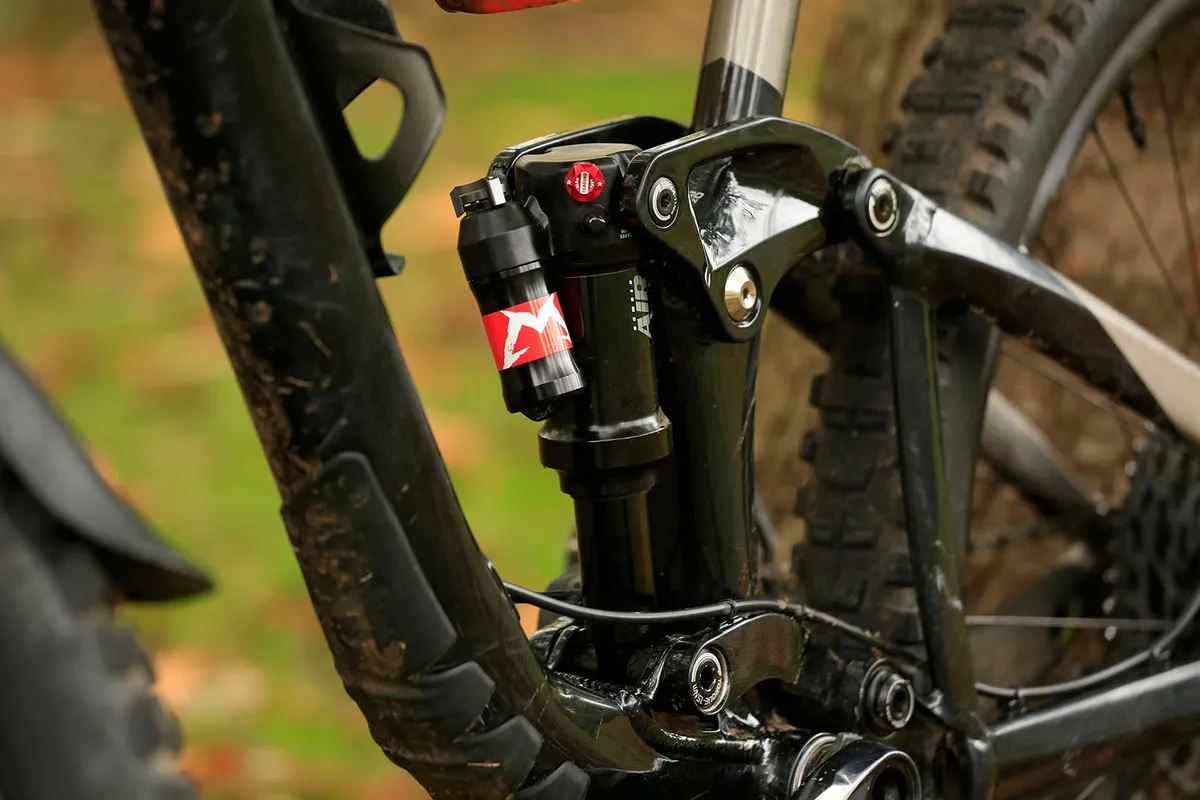
- £549/$479/€639/AU$749 as tested
- Pros: Simplicity; great performance in a range of situations
- Cons: Lack of adjustability might annoy tinkerers
The Marzocchi Bomber is a downhill-rated air shock offering simplicity and great value for money.
The asymmetric positioning of the reservoir and controls is designed to improve compatibility with a wider range of frames and to make it easier to access the adjustments.
Marzocchi keeps things simple in the form of a low-speed compression-damping dial with only a non-indexed half-turn between the firmest and softest settings, plus a rebound knob with 12 clicks.
On the trail, the Bomber Air offers traction by the bucketload. The suppleness in the mid-stroke enables control on the roughest trails without ever feeling bogged down and there’s enough bottom-out resistance for even the biggest features.
Overall, the Marzocchi Bomber Air offers great performance in a simple package.
Best MTB coil shocks
Coil mountain bike shocks are found most commonly on downhill mountain bikes and hard-hitting enduro bikes. Here, the damper consistency and minimal heat build-up of a coil shock compared to an air shock is preferable on long downhill runs.
EXT Storia LOK V3
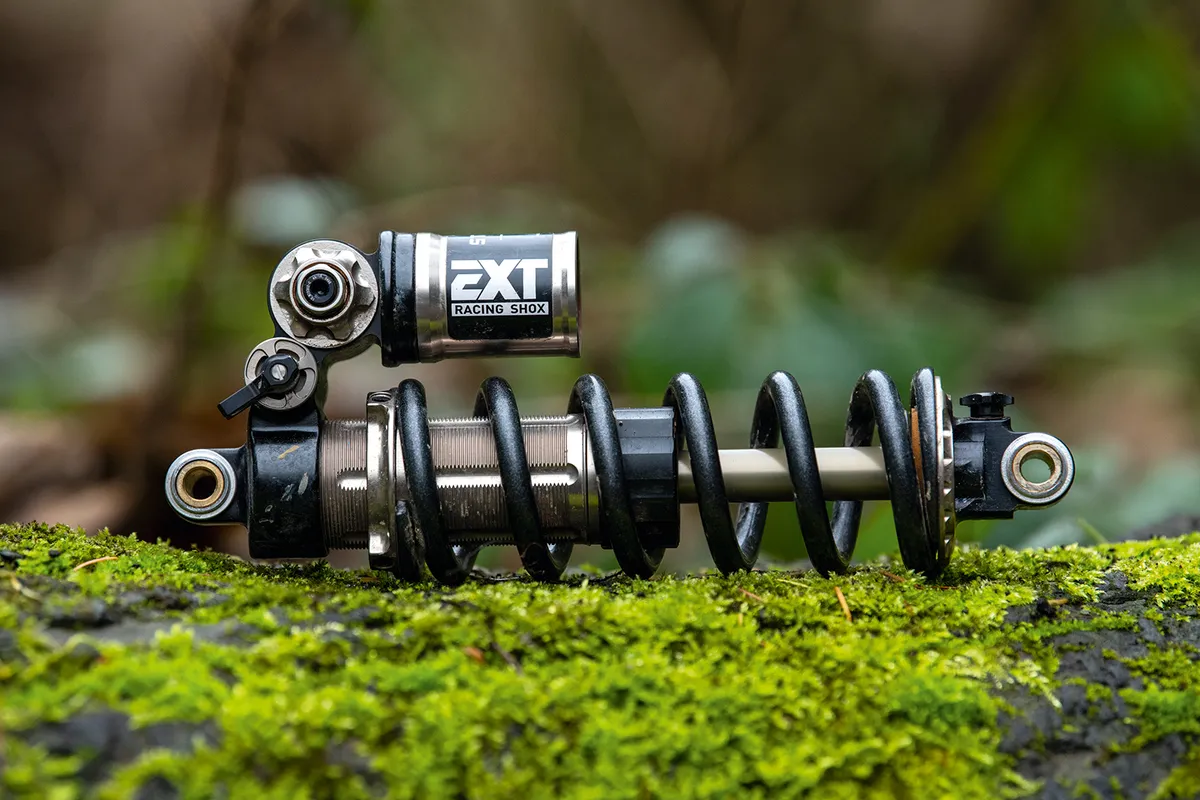
- £950/$950/AU$1,300 as tested
- Pros: High-quality build; masses of control and composure; balances suppleness, support and bump absorption really well
- Cons: Not cheap; tools required to tweak external compression damping adjusters
The EXT Storia LOK V3 is well worth a look if you want a hand-built shock to boost bike control and eke out as much traction as you possibly can.
External adjustments require a 12mm spanner/socket and 4mm Allen key to adjust the high- and low-speed compression. The rebound adjuster can simply be twiddled by hand.
The LOK lever operates a separate damping circuit to properly firm up the shock and keep it sitting higher in its travel on long climbs.
On the trail, it becomes immediately apparent just how capable the Storia is in delivering grip when speeds pick up and the terrain gets more challenging.
On repetitive hits, the Storia reacts rapidly with almost no lag as it transitions from compression to rebound, smoothing the terrain and keeping the rear tyre firmly on your line.
Overall, the Storia LOK V3 is a beautifully made shock and an incredible performer on the trail.
It’s composed and controlled in the ugliest of terrain, where it manages to balance comfort and support impeccably. When it comes to delivering that all-important traction, it’s hard to beat.
Fox DHX2
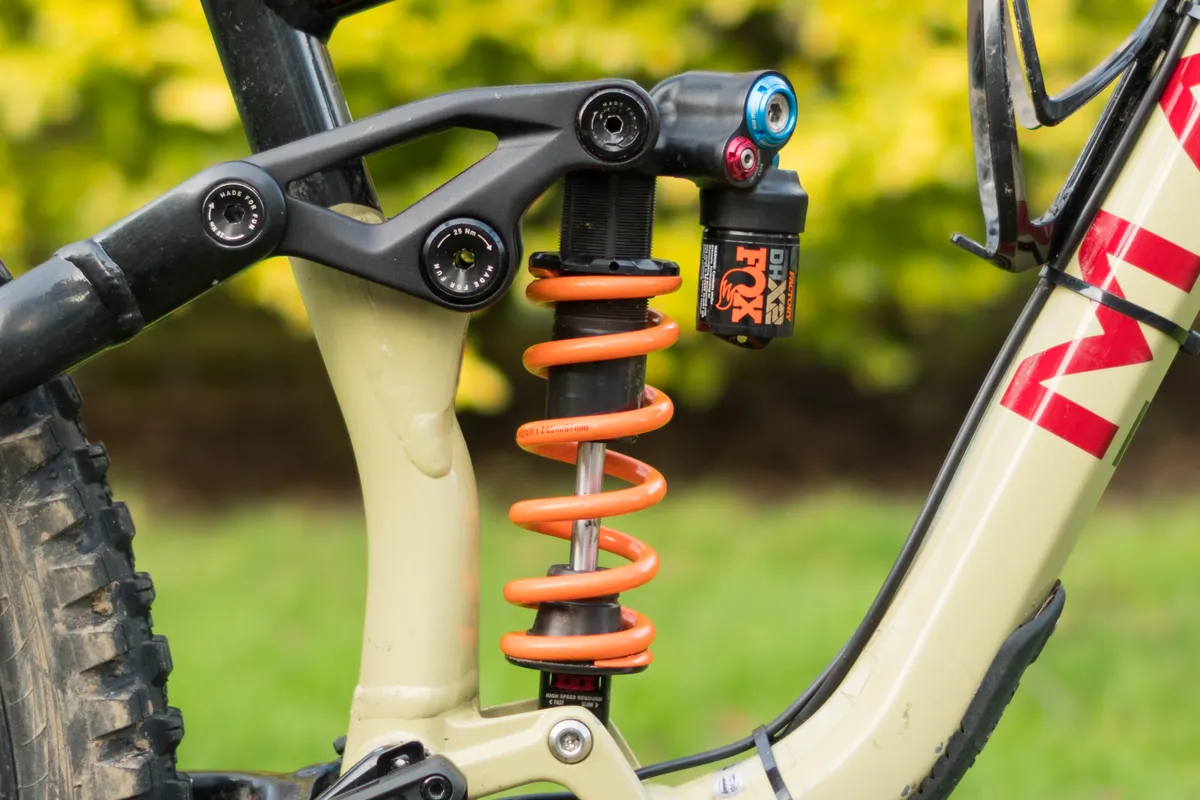
- £749/$649/AU$859 as tested
- Pros: Super-plush feeling; supple action creates ultimate grip on rough terrain; impressive mid-stroke support and bottom-out mitigation; adjusters have marked effect on shock’s feel
- Cons: Damper adjusters with stock tune need to be wound all the way out for best performance, limiting potential usability for lighter riders; rebound adjuster hard to access; bottom-out bumper quite stiff
The DHX2 Factory rear shock is Fox’s most adjustable and capable coil-sprung damper, designed to bring race-level performance to the everyday rider.
The high- and low-speed compression adjusters are easy to use, with six- and three-millimetre Allen key fittings. The low-speed rebound uses a 3mm Allen key, too, but the high-speed rebound (HSR) requires a 2mm Allen key to turn.
The shock’s on-trail feel is dominated by its super-smooth and fluttery action, where no small bump seems to go unabsorbed by the damper.
Compared to the air-sprung Float X2, the DHX2 is a step ahead in terms of smoothness and sensitivity, but this comes at the expense of spring adjustability and progression.
If you’re looking for all-out traction with solid mid-stroke support, and your bike’s suspension kinematics suit it, the DHX2 is the damper to beat.
If your priority is for mid-stroke and bottom-out control with quick spring adjustments, consider the Float X2 for similar performance.
RockShox Super Deluxe Coil Ultimate
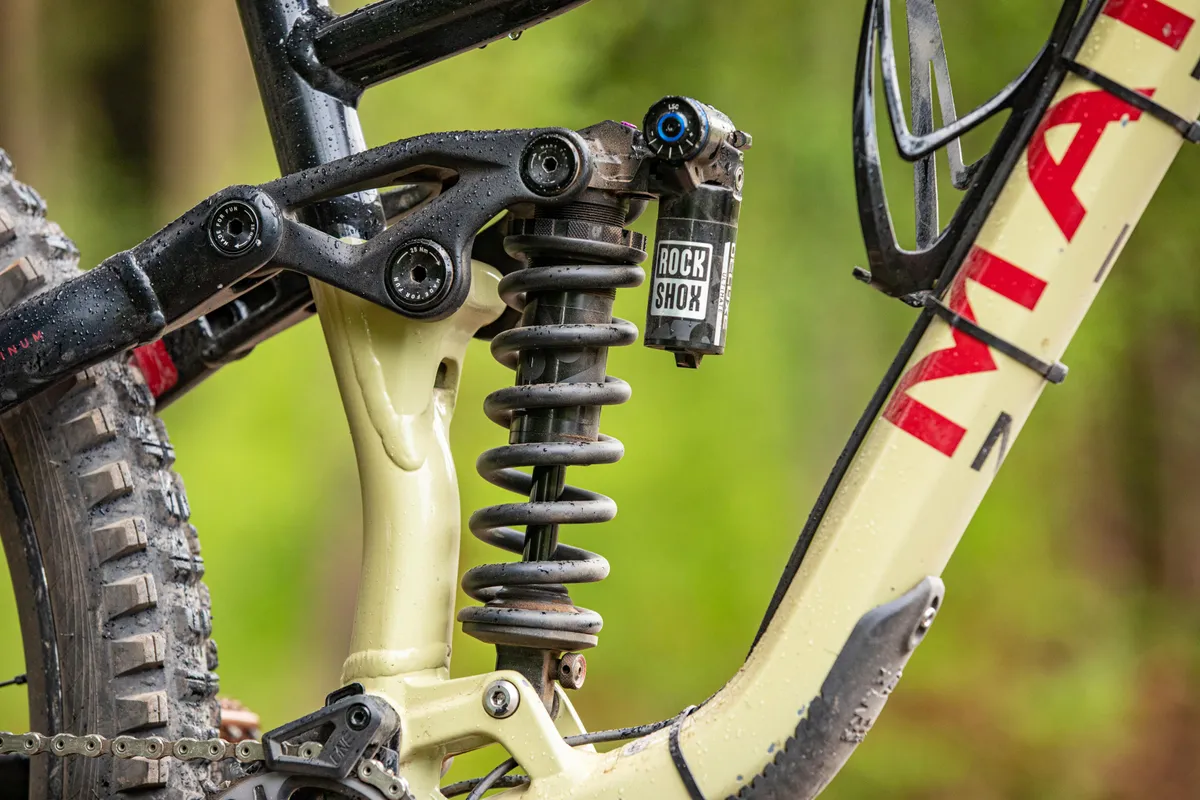
- £530/$549/€594 as tested
- Pros: HBO feature is fantastic; adjustment range supremely functional; mid-stroke support excellent; lots of tuning potential; price
- Cons: Rebound damping tune too firm; spring weight increments too big for fine-tuning
The RockShox Super Deluxe Coil Ultimate uses a hydraulic bottom out (HBO) to open up coil-spring performance to a host of linear bikes at a reasonable price.
The MTB shock is fitted with RockShox’s RC2T damper, with both low- and high-speed external compression adjustment, along with external low-speed rebound adjustment and a lock-out lever.
It features five clicks of high-speed compression adjustment, five clicks of low-speed compression adjustment and 20 clicks of low-speed rebound adjustment.
The adjustable hydraulic bottom-out (HBO) system on the latest Super Deluxe is a first for RockShox and changes how much bottom-out resistance there is.
Off the top, the Super Deluxe Coil is smooth and fluttery, absorbing trail chatter and providing plenty of comfort on worn-out trail centre surfaces or fire roads. Mid-stroke support is also commendable.
Its support and HBO were a formidable pairing on demanding tracks, both lending themselves to hard-charging riders.
The 2023 Super Deluxe is a marked improvement over the outgoing model and costs less than its direct competitors from Fox. This makes it a serious contender in the shock upgrade market for those looking for more performance.
Fox DHX

- £629/$549/€759 as tested
- Pros: Smooth off-the-top performance; great damper support in the mid-stroke; big bottom-out bumper; adjusters have a marked effect
- Cons: Needed a re-tune to access top performance; weighty and expensive; rebound adjustment still needs to be fully open
The Fox DHX coil-sprung rear shock was released alongside the Float X. Both are aimed at trail and more aggressive riding.
The DHX features external low-speed compression and rebound adjustments compared to the higher-spec DHX2’s low- and high-speed rebound and compression.
It has 11 clicks of low-speed compression damping adjustment and 16 clicks of low-speed rebound tuning. There's also an independent two-position open/firm lever designed for pedalling.
The aftermarket DHX is delivered with Fox’s stock medium rebound and compression tunes.
After a few weeks of testing, it became apparent both the stock compression and rebound damping tunes were too hard and unsuited to our test bike’s kinematics, as well as our test rider’s preferences.
After a re-tune, Fox’s DHX was nothing short of impressive out on the trails, and its performance extends well beyond the trail riding Fox says it’s designed for.
Arguably, performance is on a par with the more expensive DHX2, especially in terms of smoothness at the start of its travel and mid-stroke support. Bottom-out is just as well controlled, too.
PUSH ElevenSix
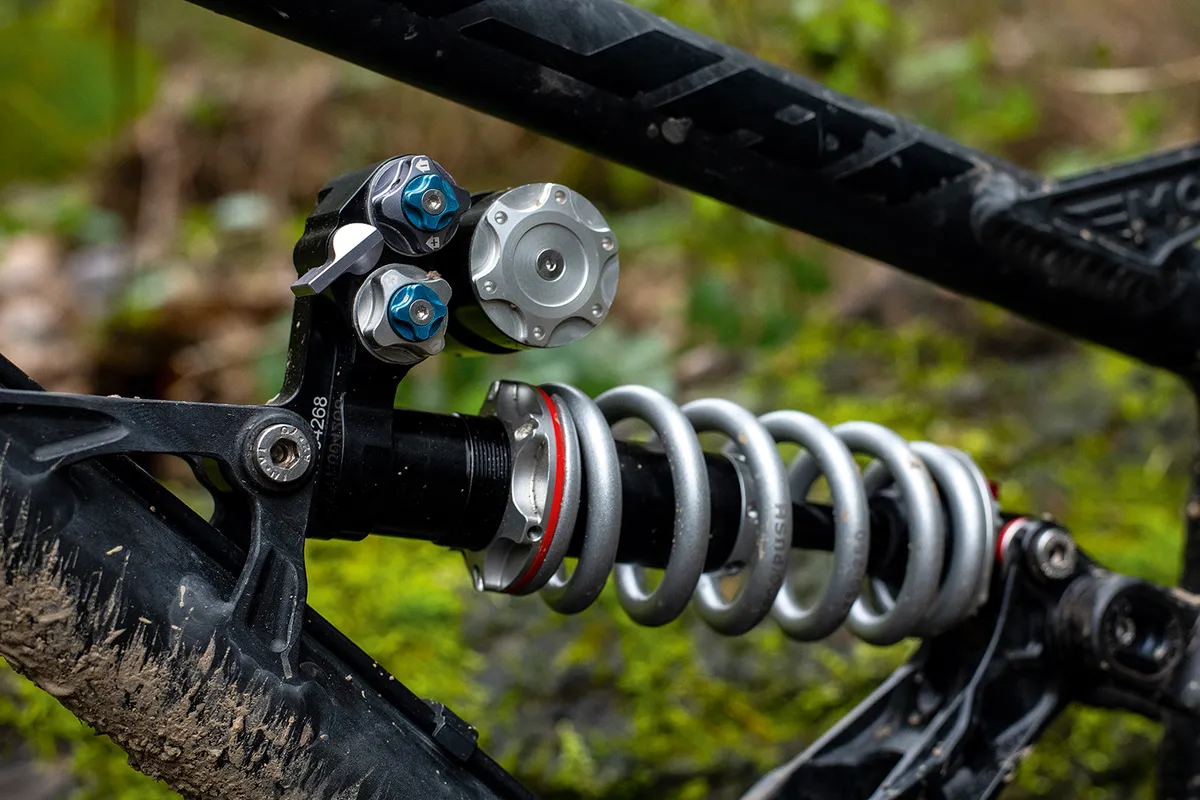
- £1,290/$1,200/AU$1,699 as tested
- Pros: Super-controlled when it counts; enough adjustment for accurate fine-tuning
- Cons: Very expensive; not the most forgiving
The PUSH ElevenSix is made and assembled by hand in Colorado, USA and tuned especially for the bike and rider.
External high- and low-speed compression damping and rebound dials enable you to tweak the shock to your preferences and give a wide enough range to make a big difference to ride feel.
At speed, the level of control and composure offered by the ElevenSix is impressive.
However, on lengthy downhill trails with prolonged rocky sections, the ElevenSix feels marginally less forgiving than the equally bespoke EXT Storia.
The ElevenSix doesn’t lack support though, and when you want to load the bike hard, there’s plenty to push against. It certainly helps to create a lively, dynamic ride, while keeping things calm and collected when it turns rowdy.
On the climbs, the firmer setting of the shock’s second circuit enabled us to maximise traction without losing much pedalling efficiency.
Buyer's guide to mountain bike rear shocks
What does the rear shock on a mountain bike do?

Just as a suspension fork allows the front wheel of a mountain bike to absorb impacts from the trail, the rear shock controls the rate of movement of the rear wheel as it moves over obstacles.
The rear shock has two jobs. It acts as a spring, absorbing the forces applied to the rear wheel to help isolate the bike and rider from the bumps. It then rebounds to its original position, in a controlled manner, ready to absorb the next obstacle so the rear tyre can maintain contact with the ground, increasing control for cornering and braking.
This is where the often-mentioned spring rate, and compression and rebound damping come into play. The spring rate and compression damping control how much force is required to move the shock through its travel.
Rebound adjustment controls how quickly the shock returns to its original position after absorbing an impact.
Should you buy an air or coil shock?
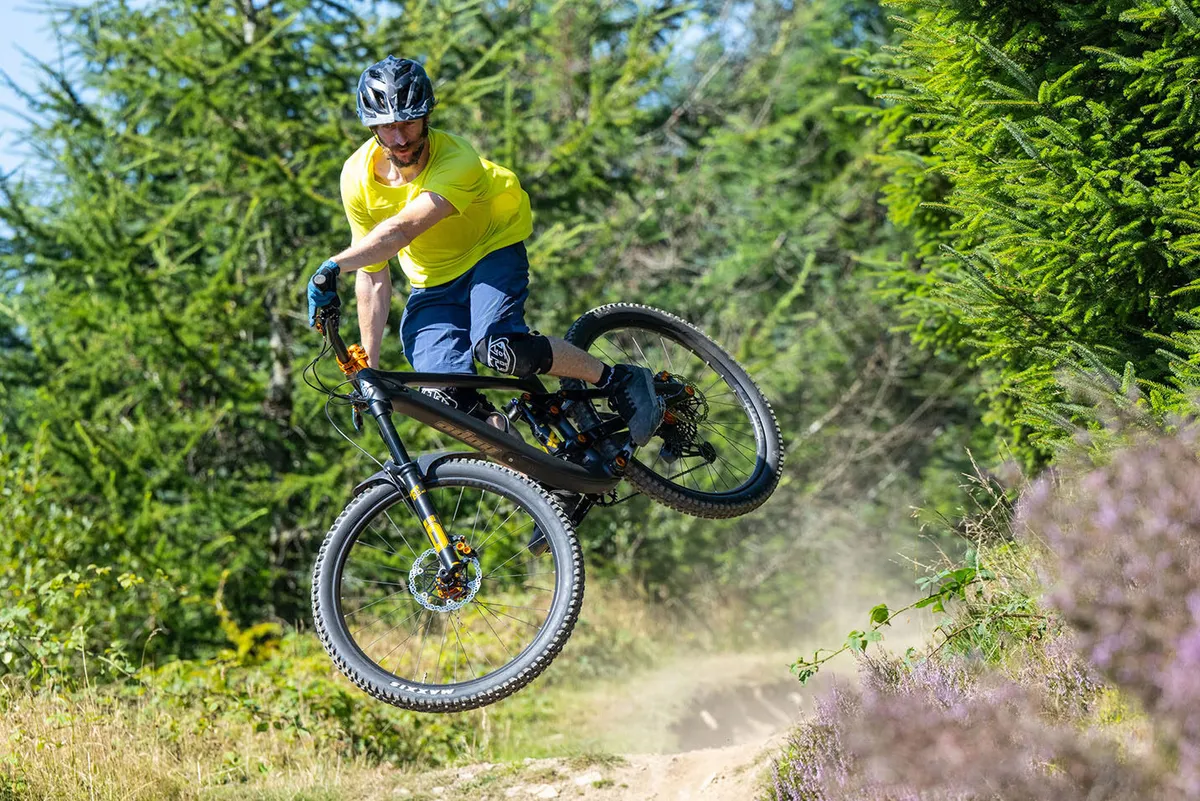
If your bike is compatible with both air and coil shocks, you may be asking which is best for you. While it comes down to personal preference, there are a few key differences to consider.
Air springs are infinitely and easily adjustable, requiring just a simple shock pump. This is why most bike brands spec air shocks as standard. They can also be made more or less progressive by adding or removing volume spacers. Plus, air shocks tend to be lighter.
Coil springs, on the other hand, can only be adjusted by swapping to firmer or softer coils, which come in specific increments and can be expensive and time-consuming to swap.
Air shocks offer riders plenty of tunability. They tend to provide more comfort in the middle portion of their travel and have a progressive ramp-up that helps prevent harsh bottom-outs.
Coil shocks are arguably slightly better on the roughest trails, being incredibly supple at the start of their travel, more supportive in the mid-stroke and offering more consistent performance on long descents.
What to look for in a mountain bike rear shock

If you're in the market for a new shock, there are some key things to look out for.
Rebound and compression adjustments
It’s important to take note of the rebound and compression adjustability on offer before making your purchase.
Almost all shocks will provide rebound adjustment, which is crucial. Too slow, and your shock will pack down in chattery sections of trail because the shock can’t extend fast enough to full travel. Too fast, and you will experience a pogo-stick effect, where the shock extends too quickly and bucks you uncontrollably.
Many of the higher-end options offer four-way external adjustment of high and low-speed compression and rebound damping. This is great if you understand the mechanics of mountain bike rear suspension and the responses involved, but it can be a little tricky and time-consuming to set up correctly for some riders.
Climb switch
If your rides often involve winch-and-plummet laps of gnarly trails and smooth fire road climbs, a climb switch may save your legs by preventing the shock from sapping energy on the uphills.
If you ride undulating terrain frequently, it may be better to leave the shock open for the duration of the ride. Most modern enduro and trail bikes are designed with polite climbing manners in mind, often negating the need for a climb switch.
If you’re into covering ground as fast as possible – think cross-country MTBs or downcountry bikes – a climb switch or lock-out may be what you want for maximum climbing efficiency.
External or internal reservoir?
The reservoir of a rear shock holds the shock’s damping oil.
Many gravity-oriented shocks feature a large external reservoir (often called a piggyback reservoir), which helps keep the damping oil cooler for longer, something that's crucial on long and rough descents.
It also allows for additional oil displacement. Shocks of this type tend to have a large shock stroke, so they displace more oil inside them with each compression, and the oil has to flow somewhere.
The downsides of a piggyback design are extra weight and size. Some frames will also be incompatible due to clearance issues.
Mountain bike shocks with internal reservoirs tend to be smaller and lighter, suited to bikes with less travel and reduced demands on the shock.
How do I know what size rear shock I need for my mountain bike?
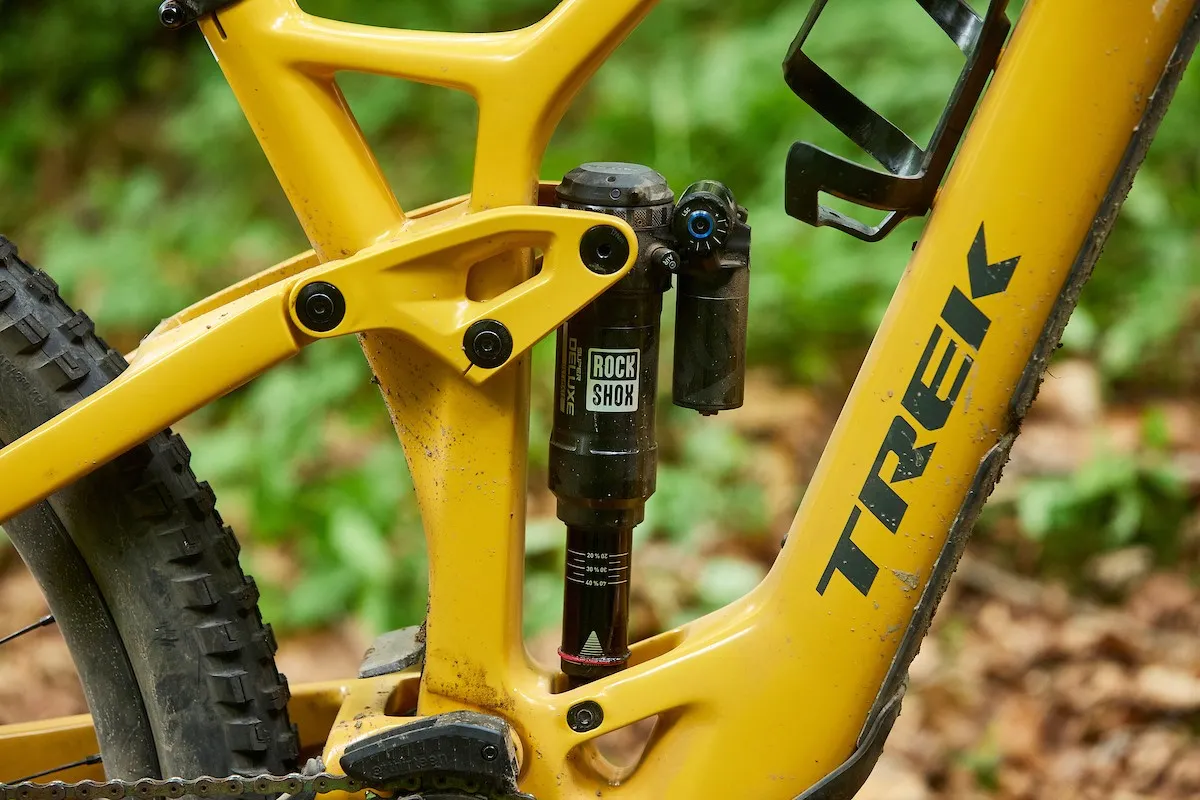
When it comes to identifying which shock is compatible with your bike, there are several factors to take into consideration.
The first is called eye-to-eye length, and refers to the distance between the middle of both mounting eyelets at the top and bottom of the shock.
Older shocks used an imperial measurement system, but modern shocks use a metric scale.
The second measurement is called the stroke. This is the distance the shock’s shaft moves when fully compressed.
Once you have the correct shock size, you need to check the mounting hardware required – this comes in the form of bushings and spacers. Each bike manufacturer has its own standards here, so it’s best to check with them directly.
Some shocks also use a trunnion mounting design, where the shock is mounted directly to the linkage by threads in the shock body.
